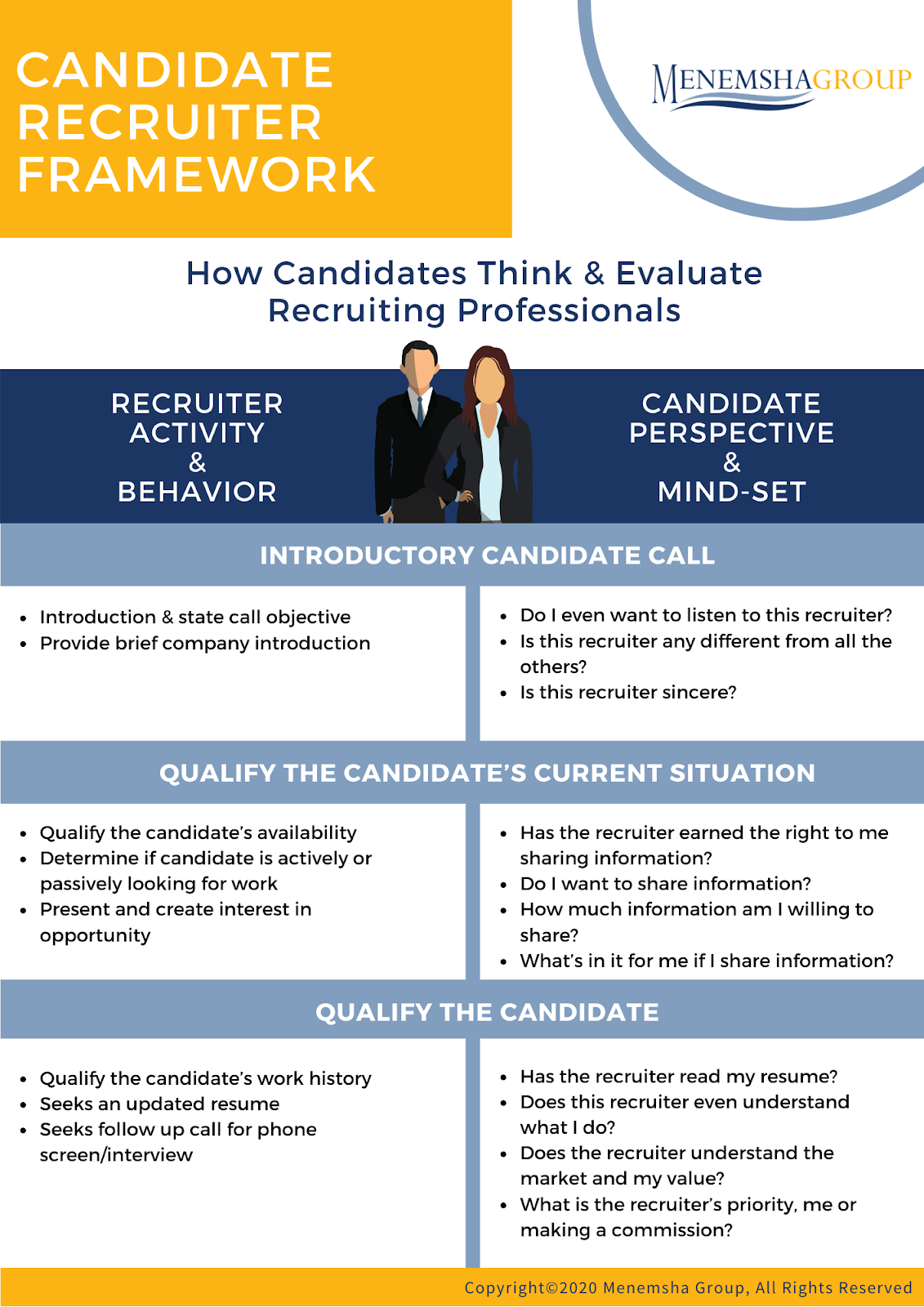Selling With Your Consultant
In my previous post, How to Prevent Unexpected Contract Terminations, I shared how systemizing consultant and client check-ins at key milestones...
9 min read
![]() Dan Fisher
:
Sep 4, 2020 4:20:10 PM
Dan Fisher
:
Sep 4, 2020 4:20:10 PM

In order to properly address and overcome candidate objections, recruiters first need to understand why they occur in the first place. To understand why candidate objections occur in the first place, you need to understand the  concept of the candidate-recruiter alignment framework and how candidates evaluate you.
concept of the candidate-recruiter alignment framework and how candidates evaluate you.
Do you think candidates are evaluating your staffing and recruiting firm including your financial viability, service offerings, core competencies, location and reputation? Or, do you think they are evaluating you, the individual recruiter and how you conduct yourself? Yes, candidates are evaluating you, the individual recruiter and not your company. The reason for this is because candidates have many options to choose from. There are tens of thousands of recruiters in which a candidate may work with. Not only that, in a tight labor market where demand outweighs supply, candidates often feel they don’t need to work with a recruiter. From the candidate’s perspective, working with a bad recruiter at best, is a waste of their time. Consider these statistics:
Before diving into the recruiter's guide to handling candidate objections, recruiters must first understand how and why they need to stay in alignment with the candidate. The candidate-recruiter framework (below) illustrates the initial steps that recruiters take when engaging a candidate for the first time including their messaging. Mapped to each message and step the recruiter is attempting is the perspective of the candidate including the thoughts and concerns weighing on the mind of the candidate relevant to what the recruiter is saying and doing.

After looking at this illustration I think we would all agree that understanding the candidate’s perspective is pretty important. Candidates have many options to consider and decisions to make when trying to select a recruiter and make a career decision. So why don’t more recruiters take the time to better understand the candidate’s perspective? Because they’re mostly focused on what they’re going to say and pitching their job opportunity. While you’re talking, your candidate is asking themselves these questions about you. Now that you know what candidates are thinking about when they receive your call, you can probably imagine some things that you have said that would create fear, doubt and uncertainty for the candidate and give them pause for engaging in the candidate interview or even sharing their resume with you.
Objection Prevention
One key area that we focus on in our recruiter training is the concept of objection prevention. What most often triggers an objection from the candidate is something the recruiter has said. When recruiters go into pitch mode and focus on touting their opportunity such as the company culture, job description or benefits, candidate’s push back with objections. Candidate’s don’t want to be pitched to or feel like they’ve been sold something. The first step to objection handling is objection prevention and the best way to prevent objections is to stop pitching to your candidate, and instead focus on aligning yourself with your candidate. If you stop pitching, what in the world could your candidate possibly object to? Nothing, and that is the point.
Two Types of Objections
As a recruiting professional you are going to encounter two types of candidate objections. There are common blow-offs and legitimate business concerns.
What is important for you to know is that none of these common blow-offs are show stoppers that will prevent you from working with the candidate or placing the candidate. This is just the candidate doing what they need to do in order to protect their most precious asset, their time.
Legitimate Business Concerns: These types of objections are in fact real, legitimate reasons for the candidate to not work with you or accept a job offer from you or your client. Common legitimate business concerns typically include one of or a combination of the following:There are other examples of legitimate business concerns but what is important for you to recognize is the difference between a common blow off and a legitimate business concern.
Unconventional But Opportune Time for Handling Objections
There may be characteristics of your company or the client you represent or certain nuances in working with you that might not be very impressive or ideal for the candidate. An example could be a long interview and hiring process or lack of interview feedback. If you know there is the potential for an objection or concern that you CAN’T change or control, then you need to be prepared to address it, BEFORE the candidate brings it up. The good news is there likely isn’t that many unimpressive things about your company or working with you, but if there, you need to be prepared to bring them up on your terms and answer any potential questions. By bringing up the objection before the candidate does allows you to address it on your terms and control how it gets handled vs. the candidate potentially catching you off guard.
It is important that you recognize and anticipate in advance what your candidate may perceive as a concern or objection so that you can proactively address concerns upfront with your candidate rather than hoping and praying they don’t notice or don’t bring it up. Know this, candidates typically will NOT openly and proactively raise their concerns. It is the recruiter’s responsibility to always be asking and probing their candidates for concerns. Bringing potential concerns or objections up on your terms gives you the opportunity to create a strategy and messaging for how you want to frame the conversation and address it with your candidate.
Preparing for Objections
In professional recruiting there are many things in which you can’t exert 100% control over such as controlling your candidate or your customer’s and the things they do or don’t do. But being prepared to properly handle an objection is not one of them. You have 100% complete control over properly preparing for objections. Despite how obvious this is, many recruiters, even those with many years of recruiting experience, are often unprepared to handle even the most basic candidate objections. In our candidate call planning course we highlight how best to prepare for and anticipate potential objections. Depending on the call objective you can and should anticipate, and plan for the most likely objections.
The Recruiter Objection Resolution Model
When handling an objection, consider the four step recruiter objection resolution model.
1.) Acknowledge the Objection, Empathize With Your Candidate. The first step is to acknowledge the candidate’s objection and demonstrate empathy. Empathy is one of the core communication skills all recruiters must master. The purpose of this step is for you to demonstrate to your candidate that you understand how they feel, and that you understand their needs and concerns. This let’s the candidate know you understand them which makes them feel understood. By first acknowledging and empathizing before you offer a rebuttal or ask a question you will connect and be able to re-frame the negative situation. For example, you might say “John, I appreciate your sharing your feelings with me regarding your concern with the salary and benefits. If I were in your shoes I would feel the same way. I want to understand your concern about salary and benefits in greater detail.”
By first acknowledging the candidate’s objection, you will have paved the way for your response to the objection. By finding out how the candidate sees the situation, you can avoid making assumptions, learn more, distinguish yourself as a recruiter who actually listens, and truly cares. This will also allow you to position your response persuasively.
2.) Ask Clarifying Probing Questions. Step two is to ask clarifying probing questions. Listening to the candidate’s concerns and then asking clarifying probing questions to understand the root cause issue and true motivation behind the objection will enable you to better craft a relevant and powerful rebuttal to the objection. For example, your candidate may say, “This offer is not as compelling as the counter-offer I received.” Regardless of how technically prepared you are to deal with this, unless you understand what the candidate truly means and what their real concern is, your response cannot be as on-target and specific as it could be if you understood more. You must ask clarifying probing questions that uncover what the concern is. For example, you might say “Please share with me, in what ways is your other offer is more compelling” “What is it about my offer that concerns you?" You also want to uncover whose concern it is. Is it your candidate’s concern, or is it the concern of their friend or spouse? Or, is the concern something a competitor-either another recruiter or the other employer with the counter offer has provoked? Keep in mind that often times the first objection is not the candidate’s real concern but rather symptomatic of the candidate’s deeper, underlying issue.Finally, when asking clarifying questions you must also uncover why a resolution to the objection is important and whether or not the objection is so concerning that it would prevent the candidate from moving forward. Keep in mind that not all objections-remember common blow offs- require the perfect rebuttal. Depending on the severity of the objection, candidates may still be willing to move forward despite there not being a perfect solution or rebuttal that fully addresses their concern 100%. Until you uncover the what, the who and the why, you’re not ready to position a credible rebuttal. Next,
3.) Position Your Credible Rebuttal. Your rebuttal is your concise response that is targeted to the specific objection. Being able to provide a succinct response demonstrates that you understand the candidate’s concern and have the ability to offer a simple solution. Whenever possible we suggest that your rebuttal be delivered in the context of a story. By framing your rebuttal in the context of a story you can optimize the quality of your rebuttal. For example, you might say “John, I’ve encountered this situation before with another candidate and a different employer and here is how we handled it.” When you provide a rebuttal in this context it validates your rebuttal because it allows the candidate to see and understand how your rebuttal has been beneficial for other candidates. It provides context because they can hear how you worked with other candidates to overcome the same concern or objection. CTA Exercise: Write down five common legitimate business concern objection and prepare a rebuttal for each. If you are new to your organization you may need to work with your manager to capture these candidate success stories.Tips For Addressing Common Blow-off Objections
When it comes to addressing common blow off objections keep in mind that it may not always make sense to demonstrate empathy based on the nature of the objection. For example, if the candidate says “send me the job description,” there is no need for demonstrating empathy. In these instances you still want to acknowledge their concern or objection but from there you can begin asking your clarifying and probing questions.
Common blow-off objections also will not require you to go through the entire four step objection resolution model. Remember, a blow-off is a quick and easy way for the candidate to get you off the phone. They’re designed to shut down the conversation. When you hear a common blow-off objection we suggest you acknowledge the blow off and immediately follow up your acknowledgement statement with clarifying questions. Most of the common blow off objections also don’t require an actual rebuttal but simply require you to ask clarifying probing questions to gather more information. In that sense, your rebuttal is your clarifying questions. Because most common blow offs are taking place during the initial connect and qualifying call or a candidate nurturing call, your goal should be to uncover additional information about the candidate.
For additional tips and ideas for engaging candidates and candidate qualification, download our eBook, Executing the Candidate Interview, Five Pillars to Effective Candidate Qualification.

In my previous post, How to Prevent Unexpected Contract Terminations, I shared how systemizing consultant and client check-ins at key milestones...

About a year ago, I was serving as the fractional revenue leader, managing sales and recruiting for a client.

If you’ve worked in staffing long enough, you’ve been trained to chase job orders.